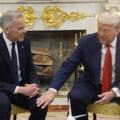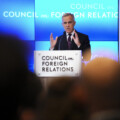In The Weekly Wrap Sean Speer, our editor-at-large, analyses for Hub subscribers the big stories shaping politics, policy, and the economy in the week that was.
A true Team Canada response wouldn’t outsource Trump’s tariff pain to one province
In the aftermath of this week’s First Ministers meeting most of Canada’s political and pundit classes have to come stand in opposition to Alberta Premier Danielle Smith and her efforts to defend the province’s oil and gas sector. I’m inclined to stand with her.
Since Donald Trump announced his threat of economy-wide tariffs against Canada, the premier has sought an exemption for the sector—and for good reason. It’s a massive source of investment, employment, and economic activity in her province, and at something like 7 percent of GDP, it’s a major driver of the national economy.
Every Canadian should want it exempted from U.S. tariffs. That would be self-evidently good for the country. That this is seemingly lost on the prime minister and other premiers exposes a fundamental problem that we’ve had in the country for too long: a mistaken assumption that the sector’s economic benefits are somehow constrained to Western Canada in general and Alberta in particular.
We’re all invested in the success of the oil and gas sector if for no other reason than its contribution to government revenues that are transferred from Ottawa to every region in the country. Ottawa’s own analysis for instance recognizes that it contributes something like $12 billion per year to federal, provincial, and territorial governments.
But the truth is there are plenty of strong arguments in favour of the sector’s national significance, including its leading role in Indigenous employment, its huge part in protecting against middle-class decline, and its major contribution to exports and national productivity.
As a leading industry voice recently said to me, if Canada’s oil and gas reserves were concentrated in Ontario and Quebec, the industry would be rightly held up as the country’s most important economic engine. But it isn’t and so it isn’t. Instead it has consistently been targeted and vilified by the federal and provincial governments as well as various anti-development intellectuals and stakeholders.
Now many of these same voices are calling on the sector to play a disproportionate role in Canada’s retaliation against the anticipated Trump tariffs. There’s been talk of curtailing production or even cutting oil and gas exports to the United States altogether. The assumption seems to be that by targeting Canada’s largest export to the U.S. by far—it’s about 30 percent higher than the next one—it will have the greatest retaliatory harm on American businesses and consumers.
Yet for Albertans, this focus on the sector is understandably frustrating. Prime Minister Trudeau has gone from talk of “phasing out” the oil sands to now seemingly wanting to make them the tip of the spear of a costly response to Trump’s tariffs.
If Canada is going to retaliate, which itself should be a matter of some debate, then the goal should be to maximize pressure and minimize harm. A big challenge with such an exercise is who gets to define harm. One gets the sense that what we’ve seen this week is Central Canadian premiers and a Central Canadian-dominated federal government deciding that the best way to minimize harm is to outsource the pain to Alberta.
A true Team Canada response would equitably distribute the costs across the country, including Ontario’s auto sector or Quebec’s hydro sector or whatever. That would be a sign that we really are all in it together.
Right now, however, one gets the sense that some of the premiers are privately rooting that the oil and gas sector doesn’t obtain an exemption so that they can use it as leverage. This is the definition of short-sightedness. Backing out oil and gas exports from Trump tariffs would reduce the share of affected exports by something like 25 percent. That’s good for Canada.
I’ve been critical of Premier Smith in the past but in this case, she’s in the right and her critics, including Prime Minister Trudeau and Premier Ford, are wrong.









